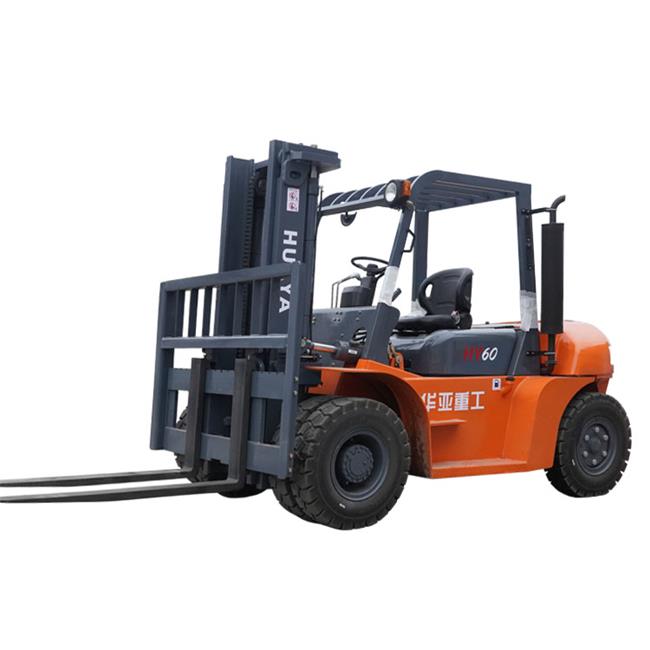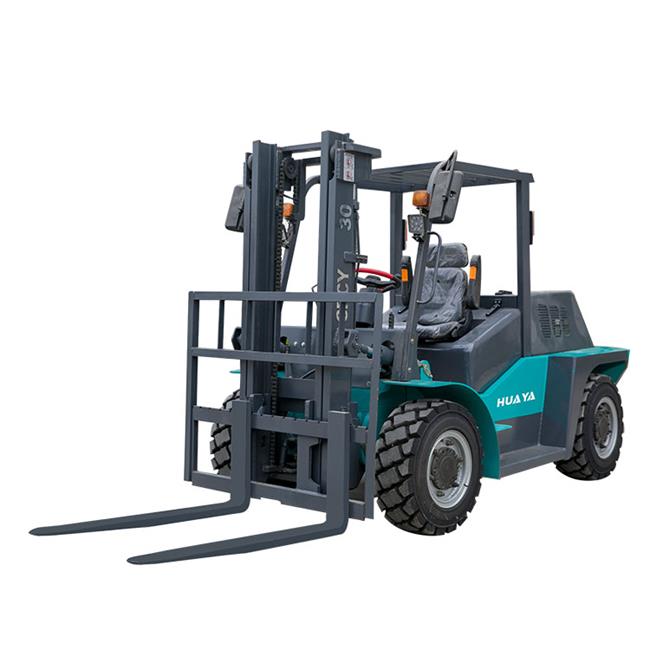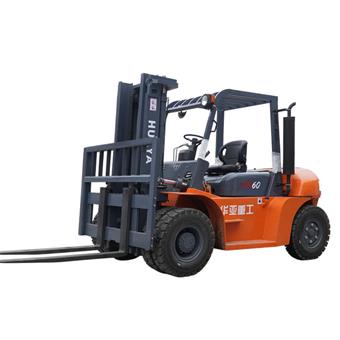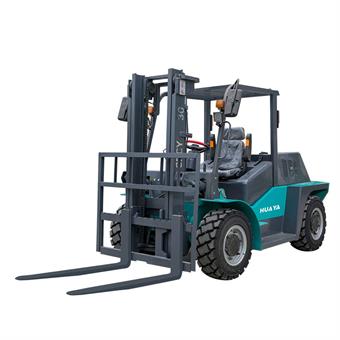
Новости
Промышленные вилочные погрузчики - незаменимые машины в различных отраслях промышленности, известные своей способностью поднимать и перемещать тяжелые грузы. Однако при выборе вилочного погрузчика одним из ключевых моментов является то, какой вес он может выдержать. Грузоподъемность вилочного погрузчика определяет его эффективность, производительность и безопасность в конкретной рабочей среде. В этой статье рассматриваются факторы, влияющие на грузоподъемность вилочного погрузчика, различные типы вилочных погрузчиков и то, как предприятия могут выбрать подходящую машину для своих нужд.
Промышленный вилочный погрузчик - это транспортное средство, предназначенное для подъема, перемещения и транспортировки тяжелых материалов на небольшие расстояния. Вилочные погрузчики оснащены гидравлическим подъемным механизмом, который позволяет им поднимать и опускать грузы, что делает их незаменимым инструментом на складах, заводах и строительных площадках.
Вилочные погрузчики используются в самых разных отраслях промышленности, включая производство, строительство и складское хозяйство. Они помогают перемещать товары, загружать и разгружать грузовики, штабелировать продукцию и организовывать материалы в складских помещениях. Благодаря своей универсальности они играют ключевую роль в повышении эффективности работы.
Грузоподъемность вилочного погрузчика очень важна, поскольку она определяет, какой вес машина может безопасно поднимать и перемещать. Перегрузка вилочного погрузчика может привести к несчастным случаям, повреждению оборудования и угрозе безопасности, поэтому важно выбирать машину с соответствующей грузоподъемностью для выполнения работы.
Различные типы вилочных погрузчиков рассчитаны на разную грузоподъемность. Например, электрические погрузчики обычно используются для легких грузов, в то время как дизельные погрузчики предназначены для работы с гораздо более тяжелыми грузами. Рельефные вилочные погрузчики предназначены для работы в суровых условиях на открытом воздухе и могут перевозить тяжелые грузы по неровной поверхности.
Тип навесного оборудования, используемого с вилочным погрузчиком, может повлиять на его грузоподъемность. Такие приспособления, как зажимы, боковые переключатели или вращатели, могут снизить общий вес, который может поднять вилочный погрузчик, из-за дополнительного веса самого приспособления. Важно рассчитать эти поправки при определении эффективной грузоподъемности вилочного погрузчика.
Центр нагрузки - это расстояние от мачты вилочного погрузчика до центра тяжести поднимаемого груза. По мере увеличения центра тяжести груза грузоподъемность вилочного погрузчика снижается. Поэтому очень важно правильно размещать грузы, чтобы сохранить весь потенциал грузоподъемности вилочного погрузчика.

Электрические погрузчики работают от аккумуляторов и, как правило, более тихие, экологичные и простые в обслуживании, чем погрузчики с двигателем внутреннего сгорания. Эти погрузчики часто используются в закрытых помещениях, таких как склады и розничные магазины.
Грузоподъемность электрических вилочных погрузчиков обычно варьируется от 1 до 7 тонн. Малые модели используются для работы с легкими грузами, в то время как большие модели подходят для работы с более тяжелыми грузами в промышленных условиях.
Электрические погрузчики обладают рядом преимуществ, таких как отсутствие вредных выбросов, низкие эксплуатационные расходы и более тихая работа. Они идеально подходят для использования внутри помещений, где качество воздуха и уровень шума вызывают озабоченность.
Одним из ограничений электрических вилочных погрузчиков является их меньшая грузоподъемность по сравнению с дизельными или газовыми моделями. Кроме того, они требуют зарядки, что может привести к простою, если не управлять ими должным образом.

Дизельные вилочные погрузчики работают на дизельных двигателях, что позволяет использовать их на открытом воздухе и в тяжелых условиях. Они обычно используются в строительстве, сельском хозяйстве и других отраслях, где требуется надежное оборудование.
Дизельные вилочные погрузчики имеют гораздо большую грузоподъемность, чем электрические модели, - от 1 до 15 тонн и более. Эти вилочные погрузчики предназначены для работы с очень тяжелыми грузами в суровых условиях.
Дизельные вилочные погрузчики долговечны, мощны и способны работать в суровых условиях. Они имеют более длительный срок службы и идеально подходят для масштабных операций на открытом воздухе, например, для перемещения тяжелых строительных материалов или крупных промышленных грузов.
Хотя дизельные вилочные погрузчики обладают высокой грузоподъемностью, они шумные, выделяют дым и требуют большего обслуживания, чем электрические модели. Кроме того, их выбросы не позволяют использовать их в помещениях.

Вилочные погрузчики, также известные как вездеходные или грунтовые погрузчики, специально разработаны для работы на неровных и труднопроходимых поверхностях. Они обычно используются на строительных площадках, фермах и на мероприятиях на открытом воздухе.
Грузоподъемность вилочных погрузчиков варьируется от 3 до 10 тонн. Прочная конструкция позволяет им перевозить тяжелые грузы по труднопроходимой местности без ущерба для устойчивости.
Эти вилочные погрузчики созданы для работы в сложных условиях, где другие машины могут не справиться. Они оснащены большими шинами, усиленными рамами и более мощными двигателями, позволяющими преодолевать неровные поверхности при перевозке тяжелых грузов.
Вилочные погрузчики для работы на пересеченной местности, как правило, крупнее, массивнее и менее маневренны в ограниченном пространстве. Их расход топлива и уровень выбросов также могут быть выше по сравнению с другими типами вилочных погрузчиков.
Таблица нагрузки вилочного погрузчика - это руководство, содержащее информацию о том, какой вес может поднять вилочный погрузчик в различных условиях. Она учитывает центр нагрузки, высоту и тип используемого навесного оборудования. Таблицы нагрузки необходимы для определения того, может ли вилочный погрузчик безопасно поднимать определенный груз.
Чтобы прочитать таблицу грузоподъемности, определите центр нагрузки и высоту подъема, а затем сопоставьте их с таблицей, чтобы найти максимально допустимый вес. В таблицах грузоподъемности также указано, как различные приспособления или аксессуары влияют на грузоподъемность вилочного погрузчика.
Понимание и соблюдение таблицы грузоподъемности очень важно для обеспечения безопасной работы вилочного погрузчика. Неправильная оценка грузоподъемности вилочного погрузчика может привести к несчастным случаям, опрокидыванию и повреждению как груза, так и оборудования.
Центр нагрузки - это горизонтальное расстояние от передней части вил вилочного погрузчика до центра тяжести поднимаемого груза. Стандартное расстояние между центрами нагрузки для большинства вилочных погрузчиков обычно составляет 24 дюйма, но оно может меняться в зависимости от типа груза.
По мере увеличения центра тяжести способность вилочного погрузчика поднимать тяжелые грузы снижается. Грузы, расположенные слишком далеко от мачты вилочного погрузчика, смещают центр тяжести и могут вызвать неустойчивость, что приведет к несчастным случаям или повреждению оборудования.
Правильное размещение грузов вблизи мачты вилочного погрузчика гарантирует, что машина сможет работать на полную мощность. Неправильное размещение не только снижает грузоподъемность, но и подвергает риску оператора и окружающих работников.
Навесное оборудование для вилочных погрузчиков бывает разных видов, например, зажимы, ротаторы и боковые сдвигатели. Эти приспособления позволяют вилочным погрузчикам выполнять конкретные задачи, например вращать грузы или зажимать продукты, которые невозможно поднять стандартными вилами.
Навесное оборудование увеличивает вес вилочного погрузчика, что снижает общую грузоподъемность. Например, вилочный погрузчик с навесным оборудованием может потерять 10-15% от своей номинальной грузоподъемности. Операторы всегда должны учитывать вес навесного оборудования при расчете предельной безопасной нагрузки.
Правильный выбор навесного оборудования гарантирует, что вилочный погрузчик сможет эффективно выполнять свои задачи без ущерба для безопасности. В разных отраслях могут потребоваться особые приспособления, поэтому важно подобрать их в соответствии с выполняемой работой.
Операторы должны пройти соответствующее обучение, чтобы понимать грузоподъемность вилочного погрузчика и уметь безопасно им управлять. Обучение должно включать в себя умение читать таблицы грузоподъемности, правильно размещать грузы и оценивать условия, в которых используется вилочный погрузчик.
Регулярное техническое обслуживание необходимо для того, чтобы вилочный погрузчик работал с максимальной грузоподъемностью. Регулярные проверки помогут выявить любой износ, который может поставить под угрозу способность вилочного погрузчика поднимать тяжелые грузы.
Операторы никогда не должны превышать номинальную грузоподъемность вилочного погрузчика. Перегрузка вилочного погрузчика может привести к опрокидыванию, потере управления, повреждению машины и груза. При расчете безопасной грузоподъемности всегда обращайтесь к таблице грузоподъемности вилочного погрузчика и учитывайте любое навесное оборудование.
На устойчивость вилочного погрузчика влияют такие факторы, как расположение центра груза, состояние шин и общая сбалансированность погрузчика. Неровная поверхность, наклонная поверхность или резкие повороты также могут повлиять на устойчивость вилочного погрузчика, особенно при подъеме тяжелых грузов.
Треугольник устойчивости - это понятие, используемое для описания баланса вилочного погрузчика. Треугольник образуется между передними колесами и центром тяжести вилочного погрузчика и его груза. Удержание центра тяжести в пределах этого треугольника обеспечивает стабильность во время работы.
Чтобы сохранить устойчивость вилочного погрузчика, операторы должны следить за тем, чтобы грузы были равномерно распределены и размещены близко к мачте. Кроме того, им следует избегать резких движений, резких поворотов и работы на неровных поверхностях.
Перед покупкой вилочного погрузчика важно оценить типы грузов, с которыми вы будете работать, включая вес, размеры и центр загрузки. Это поможет вам выбрать вилочный погрузчик с подходящей грузоподъемностью для ваших операций.
Рабочая среда играет решающую роль при выборе подходящего вилочного погрузчика. Для работы в помещениях идеально подходят электрические вилочные погрузчики благодаря низкому уровню выбросов и бесшумной работе. Для работы на открытом воздухе или в условиях пересеченной местности больше подходят дизельные или грунтовые погрузчики.
Для выполнения различных задач может потребоваться специальное навесное оборудование, например зажимы или боковые переключатели. При выборе вилочного погрузчика учитывайте типы навесного оборудования, которые могут вам понадобиться, и то, как они повлияют на грузоподъемность.
Понимание того, сколько может поднять промышленный вилочный погрузчик, необходимо для обеспечения безопасной и эффективной работы. Учитывая такие факторы, как тип вилочного погрузчика, грузовой центр, навесное оборудование и окружающая среда, предприятия могут выбрать машину, соответствующую их потребностям. Всегда соблюдайте рекомендации производителя, проводите надлежащее обучение операторов и обеспечивайте регулярное техническое обслуживание оборудования, чтобы получить максимальную отдачу от вашего вилочного погрузчика и свести к минимуму риски.


